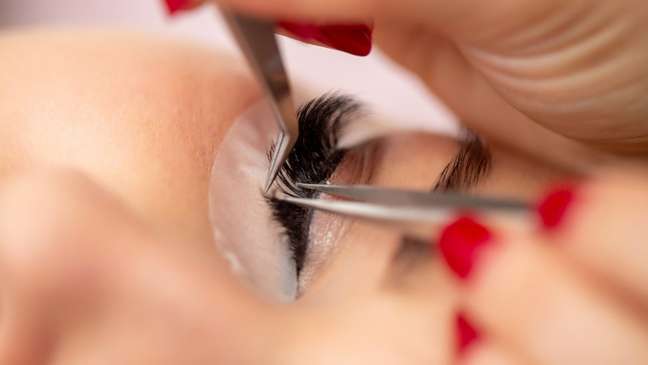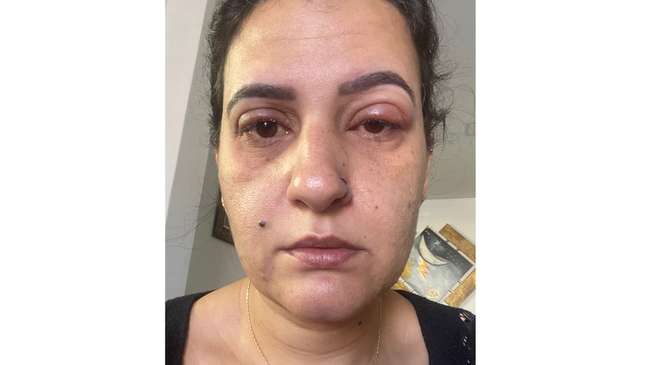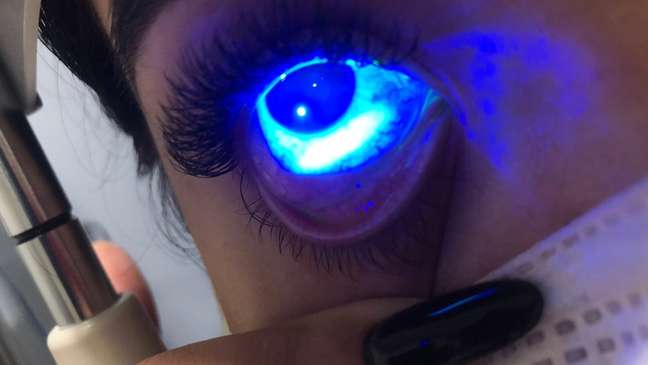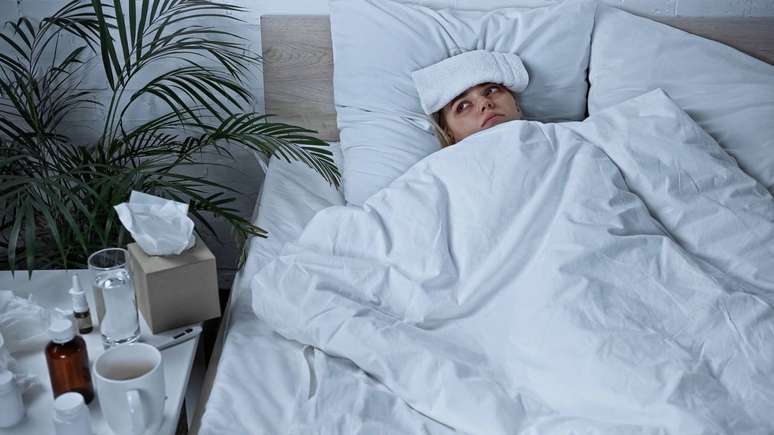Although it seems harmless, the continuous use of artificial eyelashes and poor care with threads can cause various problems, ranging from natural hair loss to more serious pathologies such as corneal ulcers.

An expert in eyelash extensions for almost a year, nurse Valéria Campos never imagined that she could develop any kind of allergy during the procedure. However, four months after doing the maintenance on the false strands – when the client returns to the salon to restore only the lashes that have fallen out over the days – she realized that something was wrong.
The nurse reports that, three hours after the surgery, her eyelids started to get red, swollen and painful.
“The professional used the same materials I was already used to. But as the hours went by, my eye swelled and hurt more and more,” recalls Valéria.
As it was Saturday night, the nurse had to wait until the next morning to return to the salon and remove the artificial eyelashes. After the blood sample she went to the emergency room of a hospital in Belo Horizonte (MG), where she was referred for urgent ophthalmological care.

“I basically couldn’t sleep that night, it was three in the morning when I woke up and I couldn’t open my eyes anymore. According to the doctor I had an infection, but he didn’t know if it was because of the glue or the synthetic eyelashes used,” he adds.
To fully recover from the infection, Valeria had to take antibiotics for seven days. While the problem has not affected her vision at all, the nurse says her natural eyelashes have not grown back and have the volume they had before the lengthening procedure.
“The amount of lashes I have has decreased because I’ve had a lot of natural hair loss,” she concludes.
Because she finds long, voluminous eyelashes beautiful, psychology student Adne Lucilla Carvalho Santos decided to have the extension procedure with synthetic threads done for the first time in July. What she didn’t expect was that she would have an allergic reaction.
A few minutes after finishing the procedure, the university student remembers that she has already started to feel discomfort in her eyes. The first symptoms of the infection were redness and burning.

“I knew it wasn’t normal to feel that pain and the next day I had a sore in my eye. I looked for eye treatment and the doctor warned me about the dangers of using eyelash extensions. I had to take antibiotics and use a ointment to relieve pain and irritation,” she recalls.
Assuming that the allergy was due to a specific product used by the professional who applied her eyelashes, after the treatment, Adne looked for another salon to put the extensions back in thread. But she again she had an allergic reaction.
“I woke up at dawn and I couldn’t open my eyes. I went to the bathroom and saw that they were very glued together and with a lot of discharge. I had to use the medication again and I saw that having eyelash extensions is not for me ”adds the university student.
Eyelash extensions and their risks
The eyelash extension procedure is nothing more than “gluing” synthetic or silk threads to each strand of natural eyelashes, making them appear longer and more voluminous.
For this type of procedure, a special glue is used.
“If possible, do a test with the substance that will be used in the extension, especially those people who tend to get irritation when using chemicals. This test is usually applied to the inner region of the arm and not to the eye. If after three days does not present any allergic reaction, the person can do it with a little more confidence,” explains Dr. Ediléia Bagatin, coordinator of the Department of Dermatological Cosmiatria of the Brazilian Society of Dermatology.
Even if it seems harmless, the continuous use of artificial eyelashes, the lack of proper cleaning and hair care can cause various problems, ranging from natural hair loss, leaving the eyes exposed and unprotected, to more serious pathologies such as corneal ulcers. .
“The eyelashes have the function of protecting the eyes from the entry of light, dust and other fragments that remain suspended in the air. Particles and residues of possible allergens are deposited there every day. The most common complication associated with eyelash extensions is blepharitis, followed by allergic conjunctivitis, corneal lesions, loss or breakage of natural eyelashes,” explains Claudia Del Claro, ophthalmologist and board member of the Brazilian Society of Ophthalmology.

The glue used is a very important factor in avoiding allergies and problems such as keratitis (chemical burns). In addition, false strands require more attention when cleaning – impurities increase the risk of eye contamination.
“To try to minimize complications, cleaning the eyelids and eyelashes with a specific non-greasy product, or even a neutral shampoo, is indicated twice a day. It is very common for patients to avoid washing their eyelashes for fear eyelash extensions fall out, but it’s quite the opposite: eyelash extensions fall out prematurely when cleaning is not done,” adds Del Claro.
What is keratitis and blepharitis
Improper placement or maintenance of eyelash extensions, or even misuse of these false strands can trigger some eye diseases. This is because in the eyelash region there are also several glands responsible for eye lubrication, which can be affected after the procedure.
Keratitis, one of the most common, is characterized by the appearance of small superficial wounds that can arise from the direct trauma of the glue used to lengthen the eyelashes with the ocular surface. These lesions, although superficial, are quite painful and are usually accompanied by a mote sensation in the eye, tearing, redness and swelling of the eyelid.
Already blepharitis is an inflammation of the eyelid that causes redness, itching and accumulation of secretion. In this disease, the fat in human tears builds up in the eyelid, increasing the risk of bacteria growing there.
“When you notice discomfort after eyelash application, the first approach is to wash the area with saline solution to eliminate possible contaminants that have reached the eye,” explains Patrícia Akaishi, ophthalmologist at Hospital das Clínicas from FMRP- USP (Faculty of the University of Medicine of São Paulo in Ribeirão Preto).
“And if the problem persists, it is advisable to go to a doctor to make sure there is no glue residue or threads on the eye surface and also to start treatment.”
Also, prolonged use of eyelash extensions can affect the arching of natural hair strands, causing them to no longer line up properly. This is because the material used in the extensions is heavier than natural strands.
“In particular, I advise against the use of eyelash extensions because it is a procedure with a high rate of complications, which can lead to permanent loss of eyelashes, which are so important for eye protection and even the glue can reach the eyes, leaving permanent sequelae on vision,” adds Del Claro, of the Brazilian Society of Ophthalmology.
What to do in case of irritation
- Rinse the eye with clean running water
- Clean your eye with a saline solution
- Don’t rub your eye (if you have an injury it can make it worse)
- Do not try to remove any object that is inside the eyeball
- seek medical assistance
– This text was published in https://www.bbc.com/portuguese/geral-64098869
🇧🇷The best content in your email for free. Choose your favorite Terra newsletter. Click here!
Source: Terra
Ben Stock is a lifestyle journalist and author at Gossipify. He writes about topics such as health, wellness, travel, food and home decor. He provides practical advice and inspiration to improve well-being, keeps readers up to date with latest lifestyle news and trends, known for his engaging writing style, in-depth analysis and unique perspectives.







